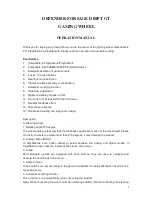
8
SHARPENING LEFT HANDED TRADITIONAL BLADES
The procedure you must use with left handed blades is similar to that procedure for right
handed blades as detailed above – Except, in all cases the slots you must use are reversed.
Where the sharpening procedure for right handed blades calls for use of the left slot, you
must use the right slot when sharpening a left-handed blade. Likewise use the left slot
where the right handed instructions call for using the right slot.
HOW TO CREATE THE ASIAN EDGE ON
EURO/AMERICAN BLADES
If you have a Euro/American brand knife, it is relatively simple to convert its edge to the low
angle Asian double faceted edge. Remember that the advantage of the Asian edge is due to the
thinner cross-section of the typical Asian blade where the edge facets are formed, and the
smaller angle (about 15°) of each edge facet. If the Euro/American style blade is thick and its
thickness at the top of its edge facets is already large, some of the advantage of the Asian edge
will not be realized. Consequently, the blade must be very thin where the facets are honed in
order to realize the advantage of the Asian edge. You might consider this change first for one of
your thinnest blades such as a thin utility blade or perhaps a thin paring knife.
To convert from the Euro/American Edge to the Asian Edge, start with the Honing Stage 1 as follows:
START IN HONING STAGE 1
Pull the full length of blade thru the left (Figure 7) and right slots of Stage 1, using the left and
right slots on alternate pulls. (Take about 3-4 seconds for each pull on a 5” long blade). It will
take about 20 pair of pulls to fully re-angle the edge of a thin blade. Thicker blades will gener-
ally require more pulls. Check for a burr and continue to make more pulls as necessary to
create a small burr along the full length of the blade. Then proceed to Stage 2 as follows.
Figure 7. European blade in left slot Stage 1.
Figure 8. European blade in right slot Stage 2.






























